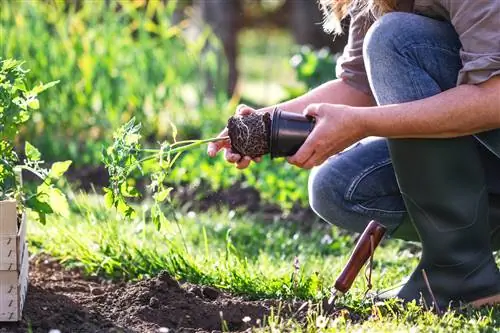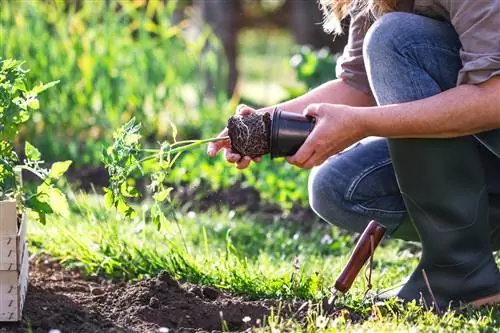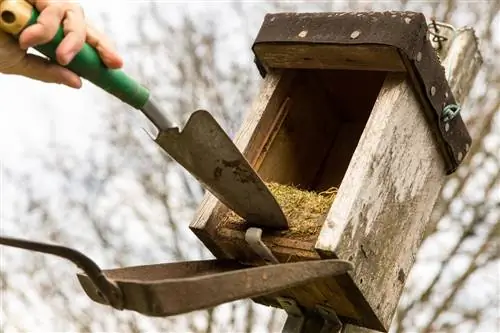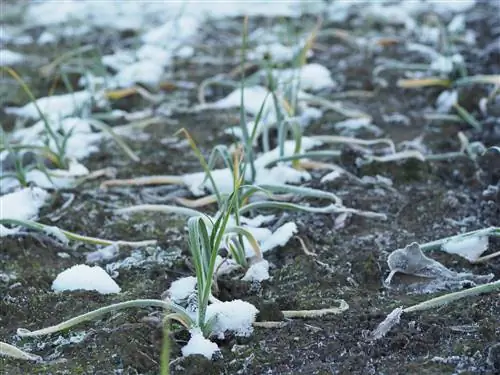- Author admin [email protected].
- Public 2023-12-16 16:46.
- Last modified 2025-06-01 06:02.
While all the plants grown on the windowsill are planted in the garden after the Ice Saints, the harvest time for some vegetables is already beginning. Nettles already have enough shoots to make a manure. Now is also a good time to turn the compost and plant tuber plants such as dahlias in the soil.

What are the most important gardening tasks in May?
In May, vegetables, summer flowers and lawns can be sown, while lettuce, radishes, herbs, May turnips, stalks, spinach and rhubarb can be harvested. It is also the right time to plant late potatoes, heat-requiring vegetables, perennials, dahlias, bulbs, conifers, azaleas and rhododendrons. In addition, the first head cuttings can be cut and faded spring flowers and climbing plants can be cut.
Summary
In the wonderful month of May, the gardener enjoys the warmth of the sun, the scent of lilacs, fresh lettuce and the first spicy herbs. But be careful: the ice saints are sure to show up, so vegetables, herbs and flowers that need heat stay in the house until May 20th as a precaution!
- Sowing: all types of vegetables, fast-growing annual summer flowers, lawn
- Harvests: Lettuce, radishes, herbs, turnips, stalks, spinach, rhubarb
- Plants: late potatoes, heat-requiring vegetables and herbs, perennials, dahlias, bulbous flowers, evergreen conifers, azaleas, rhododendrons
- Propagate: Cut and root the first cuttings of useful and ornamental plants
- Cutting: Cleaning faded spring flowers, cutting climbing plants such as ivy and knotweed
- Other gardening work: Maintenance work such as weeding, pricking out young plants, piling up early potatoes and peas, making nettle manure, clearing potted plants from their winter quarters, laying a lawn or flower meadow
Sowing in May
Almost everything that is to be harvested this season can be sown in May.
Beginning of May: it's high time for Brussels sprouts and kale. Onion sets and shallots also have to go into the ground now. Carrots, peas, sugar peas, chard, orach, kohlrabi, broccoli, chicory and beetroot must also be sown. Fill gaps in the beds with spinach, radishes and lettuce. In addition to lettuce, you can also choose summer lettuce and ice cream lettuce in May, with dark, reddish-brown lettuce varieties such as “Lollo Rosso” and red oak leaf lettuce being particularly heat-resistant.
In the first half of May: cucumbers and beans that require warmth can also be sown. By the time their cotyledons break through the earth, the dreaded ice saints are already over. Trailing runner beans are robust and not very sensitive. In May, sow annual herbs directly on the spot. The time is now particularly good for heat-loving species such as savory, marjoram and purslane. If you have already sown dill, chervil, cress and rocket, you can re-sow them again or sow them at all.
Towards the end of May: then sow late carrots, winter leeks and fennel. You can still sow fast-growing summer flowers in May: nasturtiums, marigolds, mallows and marigolds are just a few examples.
Harvests in May
If you have sown early under foil or in a cold frame, you will be rewarded with fresh lettuce, tender radishes and spicy herbs in the weeks of May. May turnips, stalks and spinach can be harvested under favorable conditions, as can the first strong rhubarb stalks.
Plants that bloom in May
- Flowers and perennials: Columbines, fairy flowers, daisies, tall bearded irises, crown emperor, corn poppies, finial, lungwort, lily of the valley, carnation root, peonies, ranunculus, sharp buttercup, pansies, Cranesbill, Bleeding Heart, Turkish Poppy, Forget-me-not
- Bulb flowers: Checkerboard flowers, grape hyacinths, tulips
- Shrubs and other trees: Barberries, blood plums, lilacs, laburnums, hydrangeas, chestnuts, cherries, magnolias, almond trees, clove cherries, pipe bushes, rhododendrons, columnar cherries, bird cherries, crabapples
- Ornamental grasses: Mountain and colored leaf sedge, blue grass
Planting and propagating in May
In May, however, we not only sow diligently, but also plant assiduously. Many useful and ornamental plants can now also be propagated using top cuttings. Cut the tender cuttings and root them in a glass of water. You can then plant the young plants obtained in this way. The months of May to August are usually optimal for propagating cuttings.
- Vegetable seedlings: All seedlings grow well in the warm, moist May soil. Only cucumbers and beans that have been grown in pots should only be planted out after the ice saints. However, you can plant salads, cabbage, kohlrabi, leeks and celery in the bed now without any worries.
- Heat-loving vegetable plants: However, caution is advised with heat-loving vegetable plants, because the nights can still be very cold in May. Tomatoes, sweet peppers and zucchini must not be planted in the garden before May 20th. Reserve a sheltered, sunny spot for them in the garden. Sweet corn and artichokes also love warmth and a location protected from the wind. Melons and eggplants are best grown in a greenhouse or cold frame, the same applies to tomatoes and peppers in harsh landscapes. From mid-May you can also plant very sensitive vegetables such as eggplants and chilies on sunny balconies and terraces.
- Potatoes: If you live in a rather cool area, it might still be too cold for potatoes there in April. You can also put them in the ground at the beginning of May. It is best to let medium-late and late varieties pre-germinate before planting out, then they will develop very quickly in warm weather.
- Herbs: In May, nurseries and garden centers offer pre-grown perennial herbs in pots that can now be planted directly in the bed: thyme, sage, mountain savory, lemon balm, various types of mint and tarragon can be planted throughout May. We have a special tip for you if you prefer basil: It is best to plant only part of it in the garden. If the summer turns unfriendly, this herb from the south thrives better in a pot on the warm windowsill.
- Strawberries: At the beginning of May, plant monthly strawberries and frequent strawberry varieties. It is best to mulch an older strawberry bed with straw so that the ripe fruits stay clean and dry. The rigid straws also keep hungry snails away.
- Perennials and bulb flowers: You can plant perennials in pots throughout May. This is a particularly good time for autumn bloomers such as asters and chrysanthemums. The dahlia tubers are planted out at the beginning of May. By the time the first shoots break through the earth, the ice saints have already passed and can no longer pose a threat to the sensitive flowers. The risk of falling victim to snails, on the other hand, is great: it is better to grow dahlias in pots and only plant them in the bed as strong plants at the end of May. Also try to find a spot here and there in the garden for summer bulb flowers such as gladioli, montbretias and peacock lilies.
- Summer flowers: Pre-grown summer flowers such as asters, snapdragons, zinnias and levkojen can now also be planted in the bed.
- Evergreen trees: All evergreen coniferous trees can now be planted. Make sure that the bales are good and that the plants never become dry until they are well established. You can still move azaleas and rhododendrons in containers even when they are in full bloom.
Cutting in May
Withered spring flowers need to be cleaned and cut back. However, with tulips, daffodils and other bulbous plants, only remove the flower stems. The foliage should only be removed when it turns yellow and dies on its own. Climbing plants are still being cleaned out and tied or guided. Ivy and knotweed now need to be cut in May.
Plant diseases and pests in May
- Snails: Snails - in the garden it is mainly the various types of slugs that are dangerous for your plants - should be collected regularly. Sawdust rings protect young beans and dahlias, and snail fences protect the seeds. Snail fences have angled edges that the hungry critters cannot overcome. Snail protection rings (sometimes called “snail collars”), which are placed individually over endangered seedlings, also help effectively. Instead of sawdust, you can also sprinkle shredded reeds, barley chaff or pine needles as a barrier. However, a defensive barrier made of lime, rock powder or Holsa ash only helps in dry weather. Organic snail pellets help with severe snail infestations.
- Lice: Spraying with plant-strengthening agents, such as nettle manure or liquid algae fertilizer, helps against aphids and other plant lice. The following natural sprays and dusts also help in acute infestations: algae dust, ash, rock dust and spray mixtures made from nettles, tansy, ferns, wormwood, rhubarb leaves or onions. If the infestation is very severe, you can also combat the pests with a soft soap broth. However, prevention is more important: ensure an environment that is gentle on beneficial insects so that lice-eating animals such as ladybirds and their larvae, hoverflies, lacewing larvae, parasitic wasps, caterpillar flies, earwigs, beetles, predatory bugs, spiders and birds feel comfortable in your garden.
- Vegetable flies: The most effective way to keep vegetable flies away from carrots, onions, leeks and cabbage is to use insect repellent nets.
- Flea beetles: Flea beetles continue to migrate when the soil is moist. That's why regular watering and mulching the beds helps against these pests.
- Apple blossom pruner and codling moth: Strips of corrugated cardboard attached to the trunks of apple trees help against these pests.
- Cherry fruit flies: To prevent cherry and other fruit flies, hang yellow glue boards in the trees.
- Whiteflies: The whitefly that often appears in the greenhouse can also be controlled with yellow glue boards; commercially available parasitic wasps can also be used as a natural control agent in severe infestations.
- Fungal diseases: To prevent fungal diseases, horsetail broth must be injected more often. You should immediately remove and dispose of rust-spotted leaves, and cut away mildew on the branch tips of gooseberries and monilia on sour cherries early on.
More gardening work in May
- Maintenance work: In warm, humid weather, the weeds are now starting to grow vigorously again. Keep the freshly cultivated beds free of wild growth so that the young vegetable plants can develop undisturbed. Where the rows of seeds are too dense, such as carrots, radishes or beets, pull out any plants that are too close together. This way the others can develop better. Early potatoes and peas can already be piled up. In May, also cut fresh nettle greens and use manure.
- Get potted plants out of their winter quarters: All balcony and potted plants that have overwintered in the house will be moved back outside into the fresh air over the course of the month. In the first half of May, only put the pots with the insensitive, hard-leaved plants outside, ideally in front of a protective wall. These include, for example, oleander, laurel, camellia and rosemary. Angel's trumpets, fuchsias and geraniums will follow from mid-May.
- Planting balcony boxes and pots: By mid-May at the latest, it is also time to plant balcony boxes and pots with all the summer flowering plants that are available in all garden centers and hardware stores.
- Creating a lawn or flower meadow: In May, the conditions for planting a new lawn or sowing a flower meadow are also favorable. Freshly sown areas must be kept evenly moist until the young greens sprout.
FAQ
What gardening work will be done in May?
It is sown and planted to your heart's content, early seedlings can now go into the bed. Even potted plants - as long as they are not hardy - are allowed outside according to the Ice Saints. Lawns and flower meadows can also be created. Beds must be cleared of weeds, emerging seedlings pricked out and initial measures taken against pests and diseases.
What is sown in May?
In May you can actually sow anything your heart desires, even more sensitive species such as cucumbers can now be planted directly outdoors - by the time they have germinated and the first delicate green breaks through the ground, the ice saints are already over. But not only seedlings, but also early-grown young plants thrive in the warm, moist May soil. Now you can also sow annual summer flowers, grass seeds for lawns and flower meadows.
What can you plant in May?
Especially young plants, but also potatoes, strawberries, perennials, dahlias, bulbous flowers and evergreen trees - especially evergreen conifers - are ideally planted in May.
What will be cut in May?
In May, the first faded spring flowers are cleaned and cut back; in bulbous plants, only the flower stalks are removed: the plants draw nutrients from the leaves in order to store them in the underground bulb. That's why you only cut off the leaves when they are yellow and dead. Climbing plants are also cleaned, tied and steered. It's time for pruning for ivy and knotweed.
What plants can you propagate in May?
From the end of May, the first head cuttings can be cut, for example from unrooted roses, hydrangeas, hibiscus, raspberries and geraniums as well as herbs such as rosemary, oregano, thyme or peppermint.






